
Floating Village, Siem Reap: Kampong Phluk & Tonle Sap
Overwhelmed by crowded tourist spots near Siem Reap? Discover the authentic charm of Cambodia’s floating villages, from Kampong Phluk’s stilted houses to Tonle Sap Lake’s seasonal wonders. This guide reveals hidden gems, practical tips, and cultural insights, helping travelers choose between serene boat rides, local communities, and seasonal transformations—all while avoiding over-commercialized traps.
Table of contents
- Kampong Phluk Floating Village: Cambodia’s Authentic Stilted Community
- Tonle Sap Lake Boat Ride: Exploring Southeast Asia’s Largest Freshwater Lake
- Prek Toal: Remote Floating Village and Bird Sanctuary
- Chong Khneas: The Most Accessible Floating Village
- Kompong Kleang: The Authentic Alternative
- Kompong Chnnang: Off the Beaten Path Experience
Kampong Phluk Floating Village: Cambodia’s Authentic Stilted Community
Kampong Phluk is a floating village on Tonle Sap Lake near Siem Reap. Built on towering stilted houses, it adapts to seasonal water levels. Famous for its unique architecture and traditional fishing culture, it offers a more authentic experience compared to other floating villages like Chong Khneas.
During dry season, Kampong Phluk’s stilted houses stand 6-10 meters above the lake bed. In rainy season, rising water submerges stilts, creating a floating appearance. This seasonal transformation shapes daily life, influencing transportation and home adaptations for residents.
Residents rely on fishing, particularly shrimp harvesting from May to October. Traditional methods include net fishing and seasonal resource management. Daily routines revolve around water levels, with families maintaining floating gardens and small-scale aquaculture to complement income from tourism.
| Category | Details |
|---|---|
| Location | Province of Siem Reap, Cambodia |
| Population (2019) | 3,707 inhabitants across 911 families |
| Etymology | Translates to « Port of Defenses » (historical trade significance) |
| Stilted Houses | Up to 10 meters high for seasonal water level adaptation |
| Main Economy | Shrimp fishing (May-Oct) + tourism revenue |
| Tourism Info | €18+/half-day group tours (boat rides + mangrove forest exploration) |
| Ecological Threats | Hydropower dams, climate change, overfishing |
Most visitors reach Kampong Phluk via organized boat tours from Siem Reap. Options include half-day trips with mangrove exploration or full-day experiences. Private tours offer flexibility, while group tours provide cost-effective access to Tonle Sap Lake’s stilted communities and floating markets.
Support local families by purchasing handmade crafts or fresh produce. Avoid intrusive photography without consent. Respect cultural norms like modest dress near religious sites. Choose eco-tourism operators like Osmose to ensure revenue benefits conservation and community development in Tonle Sap’s fragile ecosystem.
Tonle Sap Lake Boat Ride: Exploring Southeast Asia’s Largest Freshwater Lake
Tonle Sap Lake covers 2,700 km² in dry season, expanding to 16,000 km² during monsoons. As Southeast Asia’s largest freshwater body, it sustains 75% of Cambodia’s inland fish catch. Seasonal flooding creates fertile breeding grounds for aquatic life, supporting millions of people across the region. UNESCO designated it a biosphere reserve in 1997.
The Tonle Sap River reverses course twice yearly. During dry season (Nov-Apr), the lake drains into the Mekong. In wet season (May-Oct), the Mekong’s flood pulse pushes water back, raising the lake’s depth from 1m to 9m. This cycle sustains Cambodia’s fisheries but faces threats from upstream dams reducing reverse flow by 56.5% since the 1960s.
Boat tours range from 1.5-hour trips to Chong Khneas to full-day journeys to Kampong Khleang. Most include Siem Reap departures, floating village navigation, and mangrove forest exploration. Private tours cost $40+, while group options start at $18. Some packages combine lake cruises with temple visits like Phnom Krom.
- Sunscreen and hat for sun protection
- Insect repellent for mangrove areas
- Camera with waterproof housing
- Bottled water and snacks
- Light jacket for breezy conditions
Boat rides reveal flooded forests, stilted villages on 10-meter pillars, and floating markets. Watch for rare sarus cranes, black-headed gulls, and Irrawaddy dolphins. Seasonal changes transform landscapes—dry season exposes mudflats, while wet season turns villages into waterways. The lake hosts 200+ fish species and 100+ bird varieties, including globally threatened ibis and pelicans.
Visit between November and March for bird migrations or September for peak water levels. Morning tours offer soft light for photography, while late afternoons provide golden-hour views of floating homes. Avoid midday sun for clearer photos. The wet season (May-Oct) shows the lake’s full scale but brings hotter temperatures and unpredictable weather compared to cooler dry-season visits.
Prek Toal: Remote Floating Village and Bird Sanctuary
Prek Toal sits on Tonle Sap Lake, two hours by boat from Siem Reap. Approximately 2,500 residents live in stilted homes surrounded by water. This remote village combines traditional fishing with bird conservation, offering a less touristy alternative to Cambodia’s more visited floating communities.
Rainy seasons submerge all land in Prek Toal, creating a fully aquatic environment. Residents use boats for transport, trade, and daily tasks. Floating markets operate boat-to-boat, while children attend water-access schools. The community adapts completely to seasonal floods, with homes and livelihoods designed for life on Tonle Sap’s dynamic waters.
Floating vendors sell fresh fish, vegetables, and handmade goods directly on Tonle Sap’s surface. Transactions occur between boats, maintaining traditional commerce. The lake’s seasonal expansion supports these markets, with products reflecting local fishing and agricultural cycles. Visitors can sample regional specialties while observing daily waterborne trade practices.
Prek Toal’s pagoda occupies the village’s only dry land. During floods, ceremonies move to elevated platforms. This spiritual hub hosts religious festivals and community gatherings, remaining central to cultural identity despite water level changes. The structure’s seasonal adaptability mirrors residents’ resilience in Cambodia’s unique floating ecosystem.
Prek Toal Bird Sanctuary shelters endangered species like Sarus Cranes and Painted Storks. Conservation groups like Osmose work with locals to protect nesting sites. Over 20,000 waterbirds visit annually. Climate change and upstream dams threaten this ecosystem, making community-led protection efforts crucial for preserving Southeast Asia’s largest freshwater lake biodiversity.
Book tours through local operators for Prek Toal visits. Private boat rides cost $40+, while shared options start at $25. Independent travel is possible but requires negotiating transport from Siem Reap. Early morning departures recommended to avoid midday heat and maximize birdwatching opportunities on Tonle Sap’s vast, mirror-like waters.
Chong Khneas: The Most Accessible Floating Village
Chong Khneas floats on Tonle Sap Lake, positioned 15 kilometers from Siem Reap. This village attracts visitors due to its proximity, offering a 30-minute drive from the city center. Approximately 7,000 residents live in stilted and floating homes, making it the most convenient floating village experience in Cambodia.
Tourism dominates Chong Khneas’ economy but raises authenticity concerns. Visitors note over-commercialization, with souvenir shops outnumbering genuine local interactions. While some money reaches households, critics argue most profits stay with operators. Despite this, the village maintains traditional water-based living, offering glimpses of fishing and seasonal adaptation practices.
Upon arrival, tourists encounter a modern docking area with souvenir stalls and a crocodile farm. The site features floating restaurants, schools, and markets. While organized, the setting feels curated for visitors rather than showcasing everyday life. Boat operators often approach immediately, offering tours ranging from 1.5 to 3-hour lake excursions.
Visitors observe floating schools, clinics, and multi-storied restaurants built on wooden platforms. Schools operate year-round, using waterproof materials to withstand seasonal floods. The village maintains floating markets where traders exchange fresh produce and fish. Home structures combine traditional wood with modern materials, adapting to water level changes throughout the year.
Avoid overpaying for mandatory guides or « charity » rice bags sold on boats. Negotiate prices before boarding and prioritize local service providers. Support community projects like Osmose’s environmental education center. Carry exact change to prevent fake bill exchanges, a known issue at this heavily visited site.
Choose Chong Khneas for time-limited travelers seeking easy access to floating village life. Visit early morning to avoid crowds and capture morning light on waterways. Combine with nearby Angkor Wat visits for a full-day Siem Reap itinerary. For authentic experiences, consider alternative villages like Kampong Phluk or Kompong Khleang.
Kompong Kleang: The Authentic Alternative
Kompong Kleang lies 50 km south of Siem Reap on Tonle Sap Lake. Approximately 10,000 residents live in stilted homes or floating houses. This village offers a less commercialized experience compared to Chong Khneas, with traditional lifestyles preserved through seasonal fishing and water-based commerce.
Stilted houses here rise 6-10 meters above water level. Built from wood and palm leaves, structures adapt to seasonal changes. During dry season, exposed stilts reveal their full height. In wet season, homes appear to float as water reaches upper floors, showcasing architectural resilience against Tonle Sap’s dramatic water level shifts.
Fishing dominates Kompong Kleang’s economy. Fishers use cast nets and traditional traps, catching species like Mekong catfish and snakehead. The lake supplies 75% of Cambodia’s freshwater catch. Seasonal patterns dictate activity—shrimp harvesting peaks May-October while dry season focuses on maintenance and community repairs.
- Stilt Houses: Observe architectural adaptations to seasonal water levels with homes built on 10-meter stilts near Tonle Sap Lake.
- Floating Markets: Engage with local vendors trading fresh produce and goods that sustain Kampong Khleang’s daily economy.
- Traditional Fishing Methods: Learn about ancestral fishing techniques that remain central to the village’s livelihood and identity.
- Artisan Workshops: Discover basket-weaving and pottery-making practices preserving Cambodian craftsmanship in this floating community.
Daily routines revolve around water levels. Residents use boats for transport, trade, and school commutes. Floating gardens supplement food supply during wet season. Families store supplies on upper floors during flooding. Schools and shops maintain operations year-round through elevated walkways that connect homes during low water periods.
Reaching Kompong Kleang takes 1.5 hours from Siem Reap (1-hour drive + 45-minute boat ride). Group tours start at $35 per person, private options at $134. Arrange through local operators. Travel time varies with water levels—dry season allows closer approach while rainy season requires longer boat journeys through flooded forests.
Kompong Chnnang: Off the Beaten Path Experience
Kompong Chnnang floats on Tonle Sap River, 45 km north of Phnom Penh. Known as « Port of Pots » for its 6th-century pottery tradition, it features floating markets and stilted houses. This under-visited destination offers an authentic glimpse into Cambodia’s water-based lifestyle away from Siem Reap’s tourist circuits.
Minimal tourism preserves Kompong Chnnang’s traditional way of life. Residents focus on pottery-making, rice farming, and seasonal fishing rather than catering to visitors. Unlike commercialized villages, daily routines remain unchanged—boats serve as homes and transport, while families maintain floating gardens. This lack of tourism infrastructure creates a genuine experience of rural Cambodian life.
Clay pottery remains central to Kompong Chnnang’s identity. Artisans shape vessels on wooden bases, using techniques passed through generations. Visitors find handcrafted pots in local markets, where families sell directly. Floating workshops allow tourists to try pottery-making. Seasonal markets also sell fresh fish and produce, reflecting the community’s agricultural and aquatic livelihoods without commercial manipulation.
Reaching Kompong Chnnang requires a 2-3 hour drive from Phnom Penh or 5-6 hours from Siem Reap. Private cars and buses connect major cities. Boats offer scenic river journeys from Chbar Mon ferry port. Independent travel requires advance planning, as fewer tour operators service this remote destination compared to more accessible floating villages near Siem Reap.
Wat Thm Peam Krasaing’s elevated temple provides panoramic views over floating homes and rice fields. The village’s floating market operates boat-to-boat during dry season, while waterways transform into trade routes during floods. Traditional wooden houses rest on short stilts, adapting to river level changes. Unlike more touristy villages, Kompong Chnnang’s attractions remain integrated into daily life rather than staged for visitors.
For a meaningful visit, hire local guides through community tourism initiatives. Visit early morning to beat heat and observe daily routines. Respect pottery-making traditions by purchasing directly from artisans. Support village schools by bringing supplies. Follow seasonal changes—dry season reveals stilted house foundations, while rains showcase full lake immersion. Stay at floating homestays for immersive cultural exchange beyond typical floating village tours.
Discover the unique charm of floating villages near Siem Reap, from Kampong Phluk’s stilted homes to Kompong Khleang’s authentic fishing culture. Plan your Tonle Sap Lake boat ride to witness seasonal transformations and vibrant local life. For a lasting memory, visit during dry season to capture Cambodia’s water-based heritage—before rising waters reshape the landscape forever.
FAQs About the Tours
Any question ?
How many floating villages are there in Siem Reap
There isn’t a precise number of floating villages near Siem Reap, but several floating and stilted villages are located on Tonle Sap Lake. Popular choices include Kampong Phluk, known for its stilted houses; Prek Toal, a more remote floating village; Chong Khneas, the closest but most touristy; and Kompong Kleang, offering a more authentic experience.
It’s important to note the distinction between stilted and floating villages, as some move with Tonle Sap Lake’s water levels. The lake’s seasonal variations significantly impact the villagers’ lives, with fishing as a key economic activity. These villages also support diverse aquatic birds and wildlife.
What makes Kampong Phluk unique and how does it differ from other floating villages
Kampong Phluk, meaning « Harbor of the Tusks », is actually a collection of three fishing villages built on stilts rather than truly floating. The houses are constructed on 6-10 meter high stilts and only appear to be floating when the water level of Tonle Sap Lake rises during the rainy season. What makes it unique is that it’s primarily inhabited by Khmer people (around 3,500 residents) and offers a more authentic experience compared to the heavily touristy Chong Kneas village. The height of houses represents the families’ financial status – wealthier families build higher stilted houses that can survive higher floods. During dry season, visitors can walk around the village and interact with locals, while during wet season (May-October), the village truly appears to float on water.
03
When is the best time to visit Kampong Phluk and what can visitors expect to see ?
The best time depends on what experience you’re seeking. For the authentic « floating village » experience, visit during the rainy season (May-October) when the Tonle Sap River rises over 10 meters and reaches the stilted houses. During this time, you’ll see locals traveling by boat to school, feeding animals, and going about their daily water-based life. The dry season (November-April) has advantages too – you can walk around the village, interact with residents on foot, and explore the area more easily. However, April has the lowest water levels. The village is located about 30 km from Siem Reap and can be visited as a half-day trip. Visitors can explore the mangrove forest, take boat rides through the stilted houses, and experience traditional fishing and farming communities.
How much does it cost to visit Kampong Phluk and what's included in a typical tour ?
The cost varies depending on how you organize your trip. For independent travelers, expect to pay around $20 per person for the motorized boat ride through the village, plus a $2 community entrance fee, and approximately $23 for tuk-tuk, $35 for car, $40 for minivan transportation from Siem Reap. Guided tours typically range from $20-50 per person and often include transportation, local guide, boat rides through the village and mangrove forest, and sometimes meals at floating restaurants. Private tours can cost upwards of $100 or more. The boat journey usually lasts 2-3 hours and includes visits to the stilted houses, the serene flooded mangrove forest, and opportunities to observe the unique lifestyle of the fishing community. Many tours also offer sunset viewing experiences on Tonle Sap Lake.
Expert Team
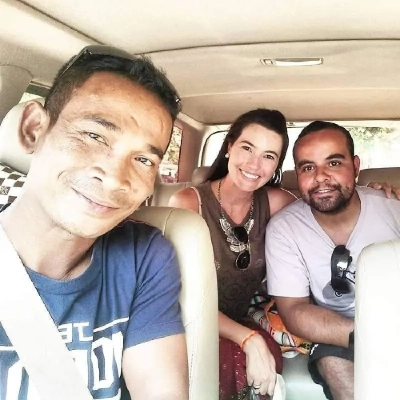
Kim Hak
MiniVan Driver
Hello Dear Valued Visitor !
My name is Kim Hak, and I’m a local Cambodian driver specializing in tourist services in Siem Reap, Cambodia. I drive a Grand Starex and offer taxi services and tours to all 25 provinces and cities (24-hour service available).
I am an experienced driver who has been driving since 2006, and I can speak English and Mandarin.
I love providing recommendations for interesting places in Siem Reap and showing my customers the best parts of Cambodia. I will ensure that my customers are well taken care of, safe, and have the best travel experience while visiting Siem Reap, Cambodia.
I look forward to showing you around Siem Reap, Cambodia! =)
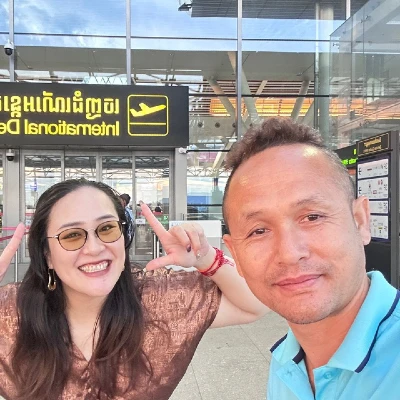
Sophara
Car Driver
Greetings, travelers! I’m Sophara, your friendly local guide and driver based in Siem Reap, Cambodia. With my comfortable SUV and Grand Starex vehicles, I’m ready to take you on unforgettable journeys throughout Cambodia’s 25 provinces and cities, any time of day or night.
Since 2008, I’ve been passionate about sharing the wonders of my beautiful country with visitors from around the world. Speaking both English and Mandarin, I bridge cultures while creating meaningful travel experiences.
I specialize in creating customized adventures that reveal both Cambodia’s famous landmarks and its best-kept secrets.. Your safety, comfort, and satisfaction are always my top priorities.
Ready to explore Cambodia with a local who truly cares about making your trip extraordinary? Let’s create amazing memories together!
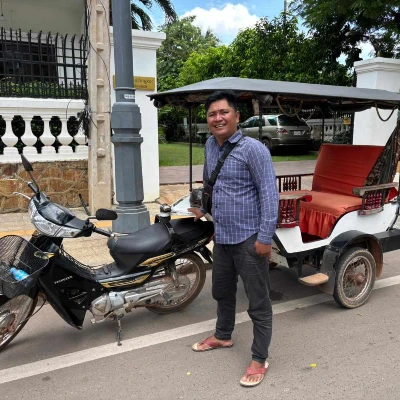
Mister Ra
Tuk-Tuk Driver
Hello there ! I’m Mister Ra, your local tuk-tuk driver and guide in Siem Reap, Cambodia. With my reliable tuk-tuk, I specialize in exploring the magnificent Angkor Wat temple complex and providing comprehensive city tours around Siem Reap.
For nearly two decades, I’ve been showing visitors the incredible temples of Angkor and the vibrant streets of our beautiful city. Speaking English fluently, I enjoy sharing stories and connecting with travelers from all corners of the world
Ready to explore Siem Reap’s treasures with a local who’s passionate about sharing his hometown? Let’s create some amazing memories together !
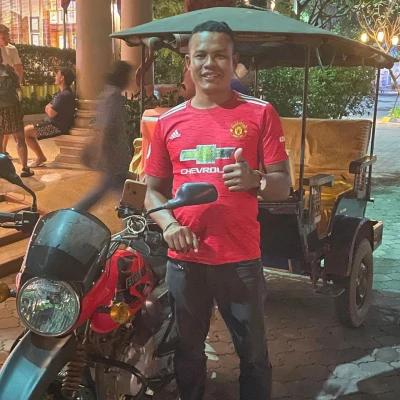
Chom
Tuk-Tuk Driver
Greetings, fellow travelers !
I’m Chom, your friendlyTuk-Tuk Driver here in Siem Reap, Cambodia.
With my reliable Tk-Tuk, I’ve been serving visitors since 2016, offering transportation and tours throughout Angkor Wat and beyond
Your comfort, security, and satisfaction are my personal mission. Every trip is designed to exceed expectations while respecting your time and budget.
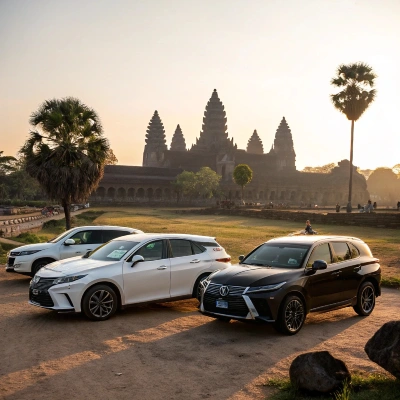
More CARS, More TUKTUK
if needed
Don’t worry we will have many other solutions when we will be fully-booked
We have many friends or relatives to call when needed
Only professional people of course